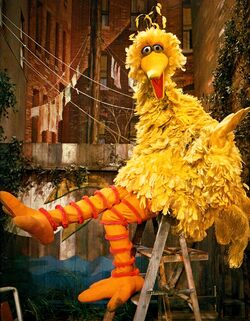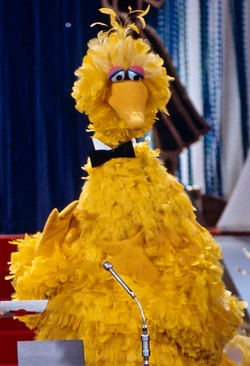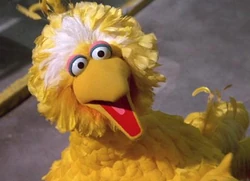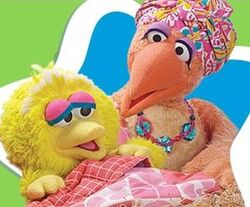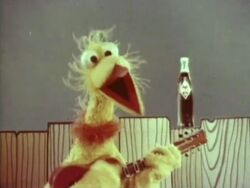No edit summary |
(not really notable and doesn’t contribute to the development of the design) |
||
| (35 intermediate revisions by 11 users not shown) | |||
| Line 6: | Line 6: | ||
|- |
|- |
||
| − | | [[ |
+ | | [[File:Bigbird1969.jpg|250px|center]] |
| − | | align=center | ''[[Sesame Street]]''<br |
+ | | align=center | ''[[Sesame Street]]''<br>[[Season 1 (1969-1970)|Season 1]]<br>(1969-1970) |
| − | | The original Big Bird is ungainly in design and characterization, with clumsy body movements and a hick-like voice. The arrangement of the feathers appears more haphazard |
+ | | The original Big Bird is ungainly in design and characterization, with clumsy body movements and a hick-like voice. The arrangement of the feathers appears more haphazard. [[Caroll Spinney]] had been quoted saying, "He looked not too keen. I thought he was one of the ugliest things I'd ever saw!"<ref>''[[A&E Biography: Sesame Street]]''</ref> |
| + | At this time, the puppet's head, neck, and torso were assembled, and buckled onto Spinney, in sections rather than as an entire unit.<ref>''The New Yorker''. [http://www.newyorker.com/online/blogs/newsdesk/2009/11/caroll-spinney-the-man-inside-big-bird.html#ixzz0X460I8KR "Conversation: Caroll Spinney, the Man Inside Big Bird,"] by Blake Eskin. November 6, 2009.</ref> Big Bird's original head design, with a paltrier amount of feathers, continued to be used as late as [[Episode 0083]]. |
||
| ⚫ | During the first season, Big Bird’s design is |
||
| ⚫ | During the first season, Big Bird’s design is continuously modified. Among the puppet’s first changes are brighter orange legs, after his original set of legs caught fire in an incident when a klieg light fell only a couple feet away. Later, the Bird's overhanging eyelids are placed higher to indicate a happier expression. |
||
| ⚫ | |||
| ⚫ | |||
| ⚫ | |||
| − | | At the end of the first season, Big Bird's head is given a full makeover. His head now has more feathers, and also has different feet. The color used to be red, now orange. |
||
|- |
|- |
||
| − | | [[ |
+ | | [[File:BigBird1970.jpg|250px|center]] |
| − | | align=center | ''[[ |
+ | | align=center | ''[[Sesame Street]]''<br>[[Season 1 (1969-1970)|Season 1]]<br>(1970) |
| + | | Late into the first season, Big Bird's head is given a makeover, with a fuller crown of feathers and mobile eyelids. The Bird's right arm, once pinned to his side, is given life through a fishing line attached from under the neck to the wrist of the left hand. |
||
| ⚫ | | For Big Bird's appearances |
||
| + | |||
| + | Spinney recalled that during that first season, [[Kermit Love]], who had built the puppet, gradually added more feathers above Big Bird's eyes. "And so he kept sneaking more and more feathers on him... until finally so that finally it was as big as a bushel basket."<ref>''[[Street Gang]]'' audiobook interview with Caroll Spinney at 36:06 mark</ref><ref>[http://www.listenandlive.com/product_info.php?products_id=347 Author Michael Davis with Narrator Caroll Spinney] Audiobook sample.</ref> |
||
| + | |||
| + | |-{{divid|bird1970}} |
||
| ⚫ | |||
| + | | align=center | [[Emmy Awards Ceremony|22nd Primetime Emmy Awards]]<br>(1970) |
||
| ⚫ | |||
|- |
|- |
||
| [[File:BIgbirdseason2.png|250px|center]] |
| [[File:BIgbirdseason2.png|250px|center]] |
||
| − | | align=center | ''[[Sesame Street]]''<br |
+ | | align=center | ''[[Sesame Street]]''<br>[[Season 2 (1970-1971)|Season 2]]<br>(1970-1971) |
| + | | Big Bird has a rounder, slightly smaller head. The Bird's voice and personality slowly begin to change, gradually becoming more childlike. |
||
| − | | Big Bird's head appears a bit shorter. His personality starts to change as the season goes on. Also, his feathers appear a bit darker. |
||
| + | |||
| ⚫ | |||
| + | | [[File:AlternateBigBird70s.jpg|250px|center]] |
||
| ⚫ | |||
| + | | An alternate Big Bird puppet was sporadically used between season 2 and the middle of season 3. Here, Big Bird's eyes are slightly further apart, more feathers are added to his head, his pupils are slightly smaller, and the blue lines of his eyelids are barley noticeable. |
||
|- |
|- |
||
| − | | [[ |
+ | | [[File:Bigbird70s.jpg|250px|center]] |
| − | | align=center | ''[[Sesame Street]]''<br |
+ | | align=center | ''[[Sesame Street]]''<br>[[Season 3 (1971-1972)|Season 3]]<br>(1971-1972) |
| − | | |
+ | | Even more feathers are added to Big Bird's head, making him his current 8'2" size. Also, his eye focus is improved. |
|- |
|- |
||
| − | | [[ |
+ | | [[File:Bbirdmid'70s.jpg|250px|center]] |
| − | | align=center | ''[[Sesame Street]]''<br |
+ | | align=center | ''[[Sesame Street]]''<br>[[Season 3 (1971-1972)|Season 3]]<br>(1972-1976) |
| − | | |
+ | | Late into the third season, Big Bird's head becomes considerably more almond-shaped. His eye focus has also been improved even more. Sometime around [[Season 5 (1973-1974)|season 5]], Big Bird completely loses the goofy quality in his voice. |
|- |
|- |
||
| − | | [[ |
+ | | [[File:Bigbird76.jpg|250px|center]] |
| − | | align=center | ''[[Sesame Street]]''<br |
+ | | align=center | ''[[Sesame Street]]''<br>[[Season 8 (1976-1977)|Season 8]]<br>(1976-1978) |
| + | | Three bright yellow highlights on Big Bird's forehead are now evident, though they have varied in size over the years. |
||
| − | | Big Bird's eye focus is now fully fixed. Some highlights are now evident on the bird's head. His head has been reshaped again. Also, his feathers appear a bit more lighter now. |
||
|- |
|- |
||
| − | | [[ |
+ | | [[File:Bb1979.jpg|250px|center]] |
| − | | align=center | ''[[Sesame Street]]''<br |
+ | | align=center | ''[[Sesame Street]]''<br>[[Season 10 (1978-1979)|Season 10]]<br>(1978-1982) |
| − | | Big Bird |
+ | | This more properly built version of Big Bird, with an even rounder head and a more shapely neck, closely resembles the current puppet. However, unlike most future Big Bird puppets, this version has the ability to completely shut his eyelids. |
|- |
|- |
||
| − | | [[ |
+ | | [[File:Followthatbirdie84.jpg|250px|center]] |
| align=center | ''[[Follow That Bird]]''<br>(1982-1988) |
| align=center | ''[[Follow That Bird]]''<br>(1982-1988) |
||
| + | | The three light yellow highlights atop Big Bird's eyes begin to form a full ring, as well as becoming even lighter in color. |
||
| − | | This version of Big Bird looks really similar to the one of today as well. There are minor tweaks and changes than the present one as of today. The quality in his eyelids is now fixed. |
||
|- |
|- |
||
| − | | [[ |
+ | | [[File:Bigbirdmailbox1990ish.jpg|250px|center]] |
| − | | align=center | ''[[Sesame Street]]''<br |
+ | | align=center | ''[[Sesame Street]]''<br>[[Season 20 (1988-1989)|Season 20]]<br>(1988-1993) |
| + | | Big Bird has a slightly taller forehead and a more slender neck. |
||
| − | | Big Bird's three highlights on his head now are very bright. Also, his neck was a bit longer during this time. |
||
|- |
|- |
||
| − | | [[ |
+ | | [[File:Bigbird90's.jpg|250px|center]] |
| − | | align=center | ''[[Sesame Street]]''<br |
+ | | align=center | ''[[Sesame Street]]''<br>[[Season 25 (1993-1994)|Season 25]]<br>(1993-2003) |
| − | | Big Bird is now somewhat more vibrant in color, compared to |
+ | | Big Bird is now somewhat more vibrant in color, compared to preceding puppets. His head takes a slightly different shape and his forehead highlights are somewhat darker. |
|- |
|- |
||
| [[File:BigBird.jpg|250px|center]] |
| [[File:BigBird.jpg|250px|center]] |
||
| − | | align=center | ''[[Sesame Street]]''<br |
+ | | align=center | ''[[Sesame Street]]''<br>[[Season 35 (2004)|Season 35]]<br>(2004-present) |
| − | | Big Bird |
+ | | Big Bird's feathers are fluffier now. His forehead is even taller, and his upper neck tends to jut out more. |
| − | In blue-screen sequences (in ''[[Elmo's World: Doctors]]'' and episodes [[Episode 4222|4222]] and [[Episode 4265|4265]], for example), the blue lines on his eyelids are changed to gray |
+ | In blue-screen sequences (in ''[[Elmo's World: Doctors]]'' and episodes [[Episode 4222|4222]] and [[Episode 4265|4265]], for example), the blue lines on his eyelids are changed to gray. |
|- bgcolor="#eeeeee" |
|- bgcolor="#eeeeee" |
||
| Line 73: | Line 82: | ||
|- |
|- |
||
| − | | [[ |
+ | | [[File:BlueBigBird.JPG|250px|center]] |
| align=center | The Blue Bird of Happiness<br>(1985) |
| align=center | The Blue Bird of Happiness<br>(1985) |
||
| − | | A blue version of Big Bird from ''[[Follow That Bird]]''. The feathers and beak are light blue, but the tail is not entirely dyed. The |
+ | | A blue version of Big Bird from ''[[Follow That Bird]]''. The feathers and beak are light blue, but the tail is not entirely dyed. The torso of this version was used for [[Blue Bird]], while the head is still used as practice for new puppeteers and was used during the screening for [[Garibaldo]], Big Bird's counterpart in [[Vila Sésamo]]. |
|- |
|- |
||
| − | | [[ |
+ | | [[File:Bigbird-j2e.jpg|250px|center]] |
| align=center | Big Bird<br>(1998-present) |
| align=center | Big Bird<br>(1998-present) |
||
| This is [[Matt Vogel]]'s Big Bird puppet. The feathers on his head are fluffier, and the blue lines of his eyelids are a slightly different color to not interfere with the blue-screen background used during the [[Journey to Ernie]] segments. When Matt performs Big Bird in street scenes, he has normal eyelid colors. |
| This is [[Matt Vogel]]'s Big Bird puppet. The feathers on his head are fluffier, and the blue lines of his eyelids are a slightly different color to not interfere with the blue-screen background used during the [[Journey to Ernie]] segments. When Matt performs Big Bird in street scenes, he has normal eyelid colors. |
||
|- |
|- |
||
| − | | [[ |
+ | | [[File:BigbirdclosedeyesQuietTime.jpg|250px|center]] |
| align=center | Alternate<br>(mid-1990s) |
| align=center | Alternate<br>(mid-1990s) |
||
| − | | During the mid-to-late 1990s, an alternate Big Bird puppet was used |
+ | | During the mid-to-late 1990s, an alternate Big Bird puppet was used in street scenes which required Big Bird to shut his eyes. It was also used during the [[Macy's Thanksgiving Day Parade]] performances during that time. It has bigger eyes and the head shape more closely resembles the 2004-present puppet. |
|- |
|- |
||
| − | | [[ |
+ | | [[File:BabyBigBird.jpg|250px|center]] |
| align=center | [[Baby Big Bird]]<br>(2006) |
| align=center | [[Baby Big Bird]]<br>(2006) |
||
| − | | |
+ | | Baby Big Bird as seen in ''[[Sesame Beginnings]]''. |
|- bgcolor="#eeeeee" |
|- bgcolor="#eeeeee" |
||
| Line 96: | Line 105: | ||
|- |
|- |
||
| − | | [[ |
+ | | [[File:JimBirdSketch63.jpg|250px|center]] |
| align=center | Gourmet Bird<ref>Inches, Alison. ''[[Jim Henson's Designs and Doodles (book)|Jim Henson's Designs and Doodles]]''. p. 100</ref><br>(1963) |
| align=center | Gourmet Bird<ref>Inches, Alison. ''[[Jim Henson's Designs and Doodles (book)|Jim Henson's Designs and Doodles]]''. p. 100</ref><br>(1963) |
||
| − | | [[Jim Henson |
+ | | [[Jim Henson]]'s earliest idea for a walk-around bird puppet was originally designed for a Stouffer's Food commercial which was never produced.<ref name="redbook">[http://www.henson.com/jimsredbook/2011/08/01/8-1969/ Jim Henson's Red Book entry about the conception of Big Bird]</ref> The drawing on the right lays out the fundamentals for how the puppet would work, which are largely the same with those that would later be applied to Big Bird. |
|- |
|- |
||
| − | | [[ |
+ | | [[File:Rc2.jpg|250px|center]] |
| align=center | [[Nutty Bird]] from [[Royal Crown Cola]] ads<br>(1966) |
| align=center | [[Nutty Bird]] from [[Royal Crown Cola]] ads<br>(1966) |
||
| While not a full-body puppet, Nutty Bird's silly appearance and warm color scheme (including his yellow base, with variations of orange and red) were traits that would be incorporated into Big Bird's design. |
| While not a full-body puppet, Nutty Bird's silly appearance and warm color scheme (including his yellow base, with variations of orange and red) were traits that would be incorporated into Big Bird's design. |
||
|- |
|- |
||
| − | | [[ |
+ | | [[File:Jimhenson-bigbird.png|250px|center]] |
| align=center | Design sketches for ''Sesame Street''<br>(1969) |
| align=center | Design sketches for ''Sesame Street''<br>(1969) |
||
| Henson's finished color sketch of his initial "goofy" vision for Big Bird. Here, the bird looks noticeably slimmer than how the actual puppet came to be. |
| Henson's finished color sketch of his initial "goofy" vision for Big Bird. Here, the bird looks noticeably slimmer than how the actual puppet came to be. |
||
Revision as of 20:41, 24 January 2020
The evolution of Big Bird.
| Image | Production / Year | Notes |
|---|---|---|
| Sesame Street Season 1 (1969-1970) |
The original Big Bird is ungainly in design and characterization, with clumsy body movements and a hick-like voice. The arrangement of the feathers appears more haphazard. Caroll Spinney had been quoted saying, "He looked not too keen. I thought he was one of the ugliest things I'd ever saw!"[1]
At this time, the puppet's head, neck, and torso were assembled, and buckled onto Spinney, in sections rather than as an entire unit.[2] Big Bird's original head design, with a paltrier amount of feathers, continued to be used as late as Episode 0083. During the first season, Big Bird’s design is continuously modified. Among the puppet’s first changes are brighter orange legs, after his original set of legs caught fire in an incident when a klieg light fell only a couple feet away. Later, the Bird's overhanging eyelids are placed higher to indicate a happier expression. | |
| Sesame Street Season 1 (1970) |
Late into the first season, Big Bird's head is given a makeover, with a fuller crown of feathers and mobile eyelids. The Bird's right arm, once pinned to his side, is given life through a fishing line attached from under the neck to the wrist of the left hand.
Spinney recalled that during that first season, Kermit Love, who had built the puppet, gradually added more feathers above Big Bird's eyes. "And so he kept sneaking more and more feathers on him... until finally so that finally it was as big as a bushel basket."[3][4] | |
| 22nd Primetime Emmy Awards (1970) |
For Big Bird's 1970 appearances on the Emmy Awards show and The Flip Wilson Show, a different puppet is used with an even larger head and cleaner feathers, indicative of Big Bird's design in later years. This puppet also sports googly pupils, similar to Cookie Monster's. | |
| Sesame Street Season 2 (1970-1971) |
Big Bird has a rounder, slightly smaller head. The Bird's voice and personality slowly begin to change, gradually becoming more childlike. | |
| Sesame Street Season 2 (1971-1972) |
An alternate Big Bird puppet was sporadically used between season 2 and the middle of season 3. Here, Big Bird's eyes are slightly further apart, more feathers are added to his head, his pupils are slightly smaller, and the blue lines of his eyelids are barley noticeable. | |
| Sesame Street Season 3 (1971-1972) |
Even more feathers are added to Big Bird's head, making him his current 8'2" size. Also, his eye focus is improved. | |
| Sesame Street Season 3 (1972-1976) |
Late into the third season, Big Bird's head becomes considerably more almond-shaped. His eye focus has also been improved even more. Sometime around season 5, Big Bird completely loses the goofy quality in his voice. | |
| Sesame Street Season 8 (1976-1978) |
Three bright yellow highlights on Big Bird's forehead are now evident, though they have varied in size over the years. | |
| Sesame Street Season 10 (1978-1982) |
This more properly built version of Big Bird, with an even rounder head and a more shapely neck, closely resembles the current puppet. However, unlike most future Big Bird puppets, this version has the ability to completely shut his eyelids. | |
| Follow That Bird (1982-1988) |
The three light yellow highlights atop Big Bird's eyes begin to form a full ring, as well as becoming even lighter in color. | |
| Sesame Street Season 20 (1988-1993) |
Big Bird has a slightly taller forehead and a more slender neck. | |
| Sesame Street Season 25 (1993-2003) |
Big Bird is now somewhat more vibrant in color, compared to preceding puppets. His head takes a slightly different shape and his forehead highlights are somewhat darker. | |
| Sesame Street Season 35 (2004-present) |
Big Bird's feathers are fluffier now. His forehead is even taller, and his upper neck tends to jut out more.
In blue-screen sequences (in Elmo's World: Doctors and episodes 4222 and 4265, for example), the blue lines on his eyelids are changed to gray. | |
| Alternate Big Bird Puppets and Characters | ||
| The Blue Bird of Happiness (1985) |
A blue version of Big Bird from Follow That Bird. The feathers and beak are light blue, but the tail is not entirely dyed. The torso of this version was used for Blue Bird, while the head is still used as practice for new puppeteers and was used during the screening for Garibaldo, Big Bird's counterpart in Vila Sésamo. | |
| Big Bird (1998-present) |
This is Matt Vogel's Big Bird puppet. The feathers on his head are fluffier, and the blue lines of his eyelids are a slightly different color to not interfere with the blue-screen background used during the Journey to Ernie segments. When Matt performs Big Bird in street scenes, he has normal eyelid colors. | |
| Alternate (mid-1990s) |
During the mid-to-late 1990s, an alternate Big Bird puppet was used in street scenes which required Big Bird to shut his eyes. It was also used during the Macy's Thanksgiving Day Parade performances during that time. It has bigger eyes and the head shape more closely resembles the 2004-present puppet. | |
| Baby Big Bird (2006) |
Baby Big Bird as seen in Sesame Beginnings. | |
| Predecessor Puppets and Planning | ||
| Gourmet Bird[5] (1963) |
Jim Henson's earliest idea for a walk-around bird puppet was originally designed for a Stouffer's Food commercial which was never produced.[6] The drawing on the right lays out the fundamentals for how the puppet would work, which are largely the same with those that would later be applied to Big Bird. | |
| Nutty Bird from Royal Crown Cola ads (1966) |
While not a full-body puppet, Nutty Bird's silly appearance and warm color scheme (including his yellow base, with variations of orange and red) were traits that would be incorporated into Big Bird's design. | |
| Design sketches for Sesame Street (1969) |
Henson's finished color sketch of his initial "goofy" vision for Big Bird. Here, the bird looks noticeably slimmer than how the actual puppet came to be. |
Sources
- ↑ A&E Biography: Sesame Street
- ↑ The New Yorker. "Conversation: Caroll Spinney, the Man Inside Big Bird," by Blake Eskin. November 6, 2009.
- ↑ Street Gang audiobook interview with Caroll Spinney at 36:06 mark
- ↑ Author Michael Davis with Narrator Caroll Spinney Audiobook sample.
- ↑ Inches, Alison. Jim Henson's Designs and Doodles. p. 100
- ↑ Jim Henson's Red Book entry about the conception of Big Bird


